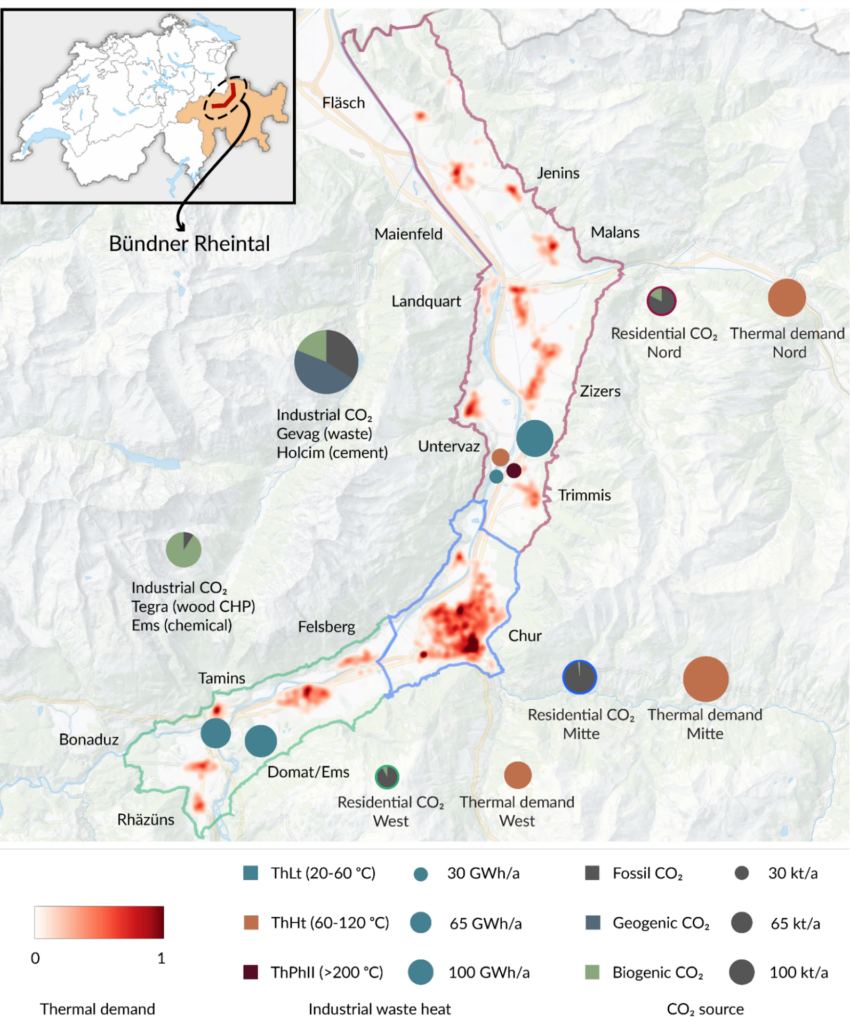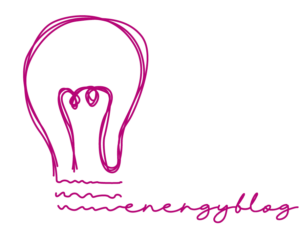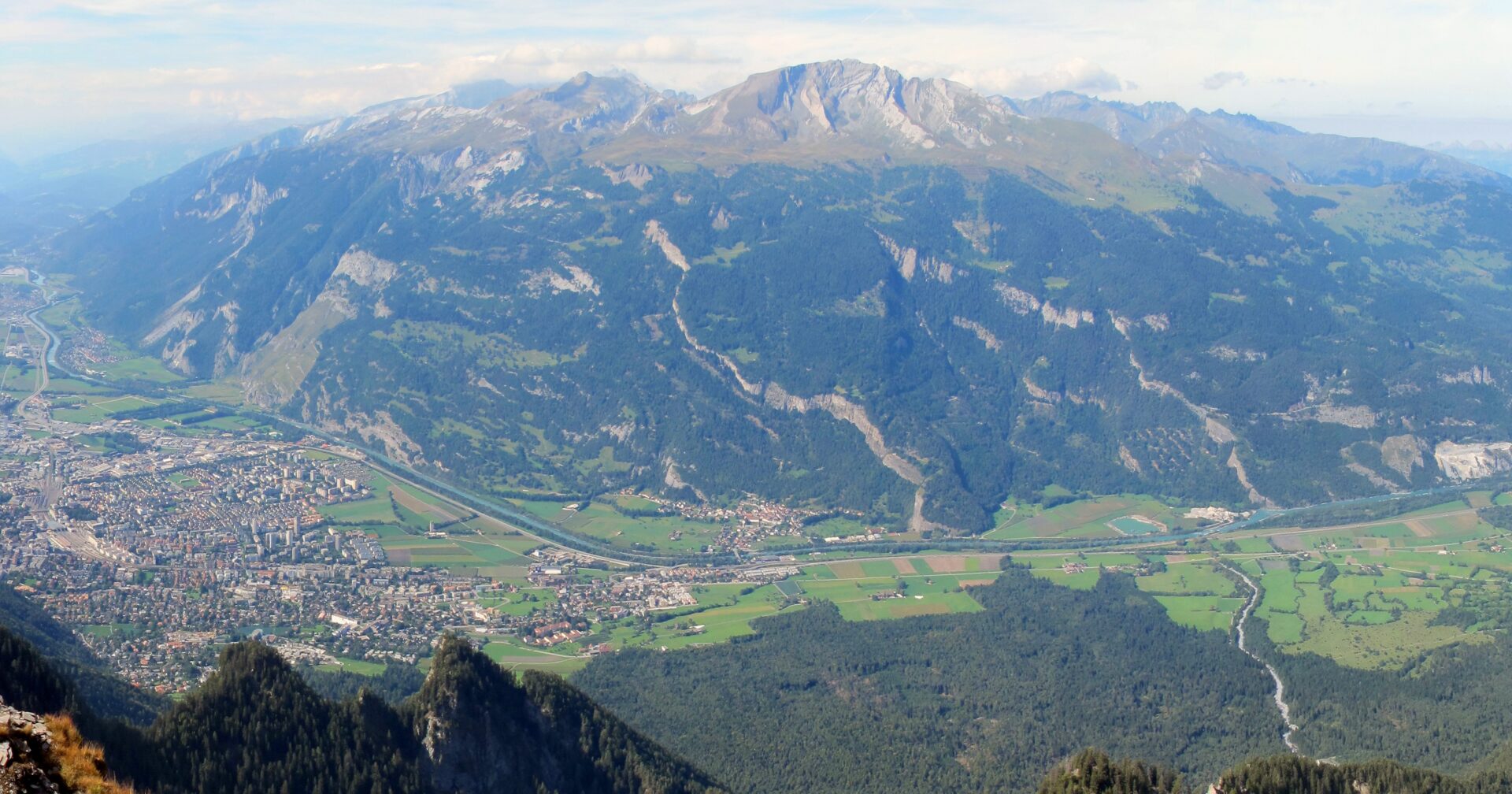How can the Bündner Rheintal, an urban-industrial cluster, achieve cost-effective decarbonization despite having CO₂ emissions per capita that are two times higher than the Swiss average? Researchers from Empa, in collaboration with the Canton of Graubünden, regional energy providers, and industry, have tackled this challenge using a holistic energy system modeling and optimization approach. The study demonstrates that decarbonization in the region by 2050 can be achieved – potentially even at reduced system cost. Through the collaboration of industry, society, and policymakers, the ambitious pathway to transform the Rheintal region to a net-zero region by 2050 is feasible. Building on these promising results, Empa and its partners are now moving forward with the concrete planning and implementation phase.
From Vision to Reality
The Bündner Rheintal is a Swiss valley located in the North of the Canton of Graubünden, stretching from Fläsch to Rhäzüns with the city of Chur at its center (Figure 1). It faces considerable challenges on its journey towards net-zero emissions by 2050. Heavy industrial activity, especially from cement production and waste incineration result in CO₂ emissions of around 11 tons per capita, which is among the highest in Switzerland. Despite this challenging baseline, a recent study by Empa, together with local industry, energy providers, and the Canton of Graubünden under the Round Table “Energiesystem Bündner Rheintal,” suggests that achieving net-zero is not only feasible but can also be economically viable, despite high investment costs.

Figure 1: System boundary of the Rheintal: Spatial distribution of thermal energy demand (qualitative), industrial waste heat at different temperature classes (low: ThLt, high: ThHt, and process: ThPhII), and CO₂ emissions [Adapted from Upadhyay et al. (2025) with map elements from Wikimedia Commons]
Collaboration as the Key to Success
The “Round Table Energiesystem Bündner Rheintal”, led by the Canton Graubünden, brought together local industry, energy suppliers, and policymakers for a series of exchanges aimed at data sharing, model validation, scenario development, and the joint development of realistic solutions. Using Empa’s sector-coupled energy system model, the region, characterized by a dense mix of urban infrastructure and industrial activity, was modelled by integrating the electricity, heating, mobility, and industrial sectors. This type of setting, often referred to as an urban-industrial cluster, presents both complex challenges and unique opportunities for decarbonization. This holistic approach allowed the collaboration to identify targeted actions for achieving a cost-effective and sustainable energy system by 2050.
Scenario Development for 2050
To comprehensively explore potential future energy pathways for the Rheintal, two contrasting scenarios for the year 2050 were developed: a progressive and a restrictive scenario. The progressive scenario envisions rapid technological and policy advancements, including a full integration of the European Hydrogen Backbone through Switzerland and a substantial expansion of the electricity grid. In contrast, the restrictive scenario assumes slower progress, with limited grid expansion, no or limited European Hydrogen Backbone access, and higher import costs. These scenarios help highlight both the opportunities and limitations the region may face on the path to net-zero emissions.
Empa’s in-house sector-coupled ehubX optimization framework was deployed to build, calibrate and validate a model representing the “current state” of the system, based on recent historical data. Using this validated model as a baseline, the future system was modelled following the energy-hub concept and integrating the full carbon cycle. The solution space for achieving net-zero emissions by the snapshot year 2050 was then explored via optimization methods.
Irrespective of the scenario, three practical measures emerge from the optimization results as essential building blocks for decarbonization of the Rheintal:
Practical Measures for Decarbonization:
- Efficient Electrification: Shifting transportation and heating from fossil fuels to electricity significantly reduces emissions. When combined with building renovations, this transition can lower primary energy consumption by up to 25% and eliminate most CO₂ emissions from the building and mobility sectors.
- Implementing Carbon Capture: Since the cement industry and the regional waste incineration plant are “hard-to-abate” emitters, Carbon Capture and Storage (CCS) is key to reducing CO₂ emissions from those sectors. The biogenic fraction of the captured CO₂ furthermore holds potential for utilization in CCUS processes, which are currently under investigation together with the partners in the Rheintal.
- Utilizing Industrial Heat: The large industries generate substantial amounts of waste heat. By expanding district heating networks, this waste heat can be repurposed efficiently, making the waste heat especially valuable during the winter months. The extended infrastructure serves a threefold purpose: it contributes to the local heat supply, relieves the pressure on the electricity grid, and provides the high-temperature heat required for CO₂ capture processes.
By 2050, the valley’s dependence on energy imports is expected to decrease. Renewable fuels, such as hydrogen and synthetic -or bio-methane, could play a crucial role in the future energy mix, particularly in ensuring a diversified and stable energy supply during winter months. However, the price of hydrogen coupled to the connection of Switzerland to the European Hydrogen backbone remains a critical barrier to adoption, as (cheap) hydrogen can compete with grid electricity imports.
Economic Benefits Are Clear, but High Investments Are Needed:
Empa’s modeling results reveal that implementing these decarbonization strategies can significantly reduce annualized system costs, potentially by up to 20-40% compared to current expenditures. The primary driver of this cost reduction was a 30% decrease in urban space heating demands due to building renovations and retrofitting, along with lower industrial energy requirements and increased energy efficiency of industrial processes. An increase in the usage of local energy resources with PV rooftop systems, heat pumps upgrading ambient heat for thermal needs, and the utilization of valuable waste heat in the valley further reduced the costs. Additionally, the electrification of building heat and mobility, combined with a shift to cleaner fuels, decreased the imports of expensive fossil fuels in the system. Thus, decarbonization becomes not just a sustainability target, but also an economically advantageous strategy which furthermore increases the resilience of the system due to the decreased dependence on energy imports. However, high upfront investments are required, in particular for the CCS infrastructure. Due to significant uncertainties surrounding carbon capture technologies such as the high and variable investment and operating costs of capture plants, evolving regulatory frameworks, fluctuating CO₂ prices, and unclear long-term revenue potentials from negative emissions credits, further evaluations and detailed business plan analyses are required before a final investment decision can be made.
Moving Forward Together:
The Bündner Rheintal initiative shows that ambitious climate targets can be achieved through integrated regional action. However, this transformation depends on overcoming key challenges such as securing infrastructure investments, coordinating diverse stakeholders, and establishing supportive regulatory frameworks. For example, enabling the cross-border transport and permanent storage of captured CO₂ will require clear legal pathways and permitting processes, which are currently lacking or inconsistent in many jurisdictions. To accelerate progress, policymakers must now provide long-term, stable frameworks that reduce investment risks and foster collaboration across sectors. Industry partners can lead the way by piloting and scaling breakthrough technologies, while municipalities and communities can drive adoption through local engagement. Continued cooperation between policymakers, industry, science, and the community will be crucial to turning this promising blueprint into reality, setting a replicable example for decarbonizing similar regions across Europe.


